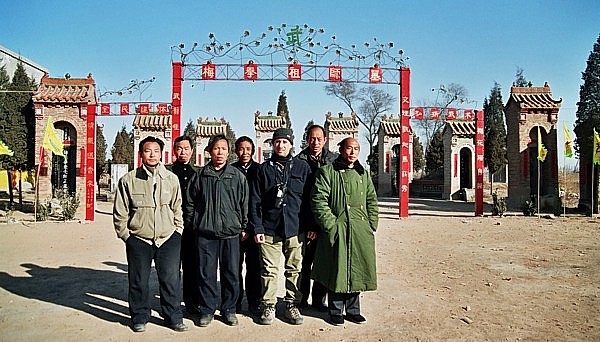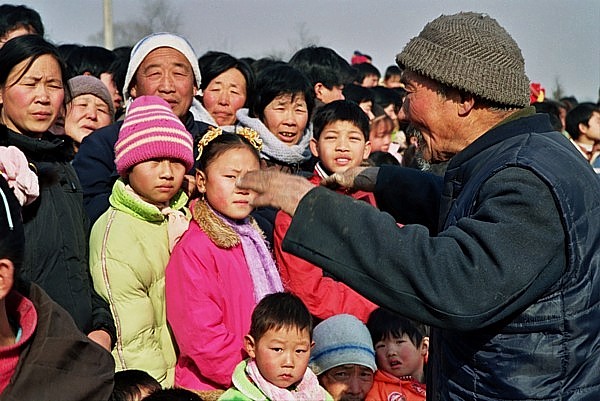|
The Spirit and Style of MeihuazhuangThe Structure of MeihuazhuangThe school is comprised of two complementary subcomponents: the Wuchang (martial aspect) and the Wenchang (civil or arts aspect). The Wuchang is the foundation of the school and is concerned with the physical training regimes, cultivation of the body, qi and shen. The Wenchang guides all activities of the school and is concerned with advanced training in qigong/neigong methods, theory, martial strategy, geomancy and numerology. 
Two subsets of Meihuazhuang are widely popular in North China. Large Frame (Dajia) and Small Frame (Xiaojia) meihuazhuang are common in the homelands regions. The school is divided roughly into two subsections, the Dajia (Large Frame) and the Xiaojia (Small Frame). The older Large Frame is practiced extensively in rural north China. The Small Frame is a newer branch of meihuazhuang, and is not as widespread as the Large Frame. The 8th generation master Zhang Congfu created the Small Frame Jiazi (the set we practice) from the original Large Frame school. This was considered a great advancement in that it more efficiently combined the physical training methods from the martial field of the school (wu chang) and the theoretical training methods from the theory field (wen chang). The training methods of the two subsections differ considerably according to locality. Both sections however, utilize the same theory texts/classic texts and share many principles. Both consider themselves as a part of the larger school and promote friendship and frequent exchanges of martial knowledge at frequent exhibitions and demonstrations held during the Spring Festival and other times throughout the year. Meihuazhuang practitioners from Shandong University have regularly attended the countryside exhibitions since the late 1980s. Xiaojia meihuazhuang is a more recent variant. Regardless of which variant a practitioner follows or the regional variations in practice methods which have evolved over the centuries, all are considered to be manifestations of one meihuazhuang school united through the wenchang &8212; a common philosophical and theoretical body. Large Frame and Small Frame aspects of the style both follow the same classic theory texts and follow the same martial lineage. Inner-door practitioners of Meihuazhuang have a generational character which identifies them to other teachers or practitioners. According to the “Meihuazhuang is one family” tradition and the peculiar social organization of the sect in the countryside, student of Meihuazhuang are regularly taught by other teachers. 
In China, meihuazhuang is practiced by both young and old and is an excellent method to develop self-defense skills and improve overall health. It tonifies the body, prevents illness, helps with recovery from illness and brings great strength and flexibility. Most importantly, it teaches practitioners methods of mental and physical relaxation and frees the body and mind from restrictive rigidity in both thought, body posture/positions and incorrect holding/movement patterns. When the body and mind are freed of restrictive thought and movement patterns, the qi (the body's energy) can flow without impediment, the mind becomes sharp and flexible and enables unimpeded, liberated movement characterized by relaxation and strength. Freedom from restrictive thought patterns, muscular tension and stress results in greatly improved overall health and vitality. Throughout all stages of meihuazhuang training, this union and freedom of both the mind and the body is a core concept which guides the training methods. Meihuazhuang is based upon a basic training routine known as the Jiazi. Not overly complex, it combines five static postures (zhuangbu) with moving footwork (xingbu). When watching the practice of meihuazhuang, one is struck by its straightforward simple methods. Its practice routines are devoid of difficult, flowery embellishments and are characterized by simple, flowing movements. Basic Philosophical PrinciplesMeihuazhuang is said to possess Four Abilities (Si da gongneng) which benefit its practitioners in the following ways:
This style is of interest not only to martial arts practitioners but to those interested in alternatives to western concepts of health. A person's health is perceived as interconnected with the environment. Individuals harmonize their mental and physical health with nature through various Qigong healing exercises. The style's traditional philosophy and its application to personal health through physical and intellectual exercises will be of interest to those involved in areas of religious and Asian studies, anthropology, psychology, and sociology. 
Notes on MeihuazhuangMeihuazhuang emphasizes physical training for the development of martial skills, for maintaining health, for healing others through qigong and for developing the intellect. Its training methods focus on liberating the body and mind from fixed patterns of movement and thinking. Training of the qi and shen is of utmost importance and all training methods are based on this goal. Meihuazhuang is considered both an internal and external style.
Also in this section:
|

